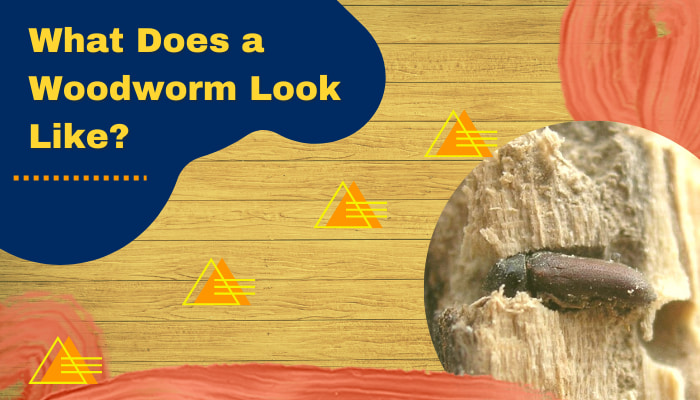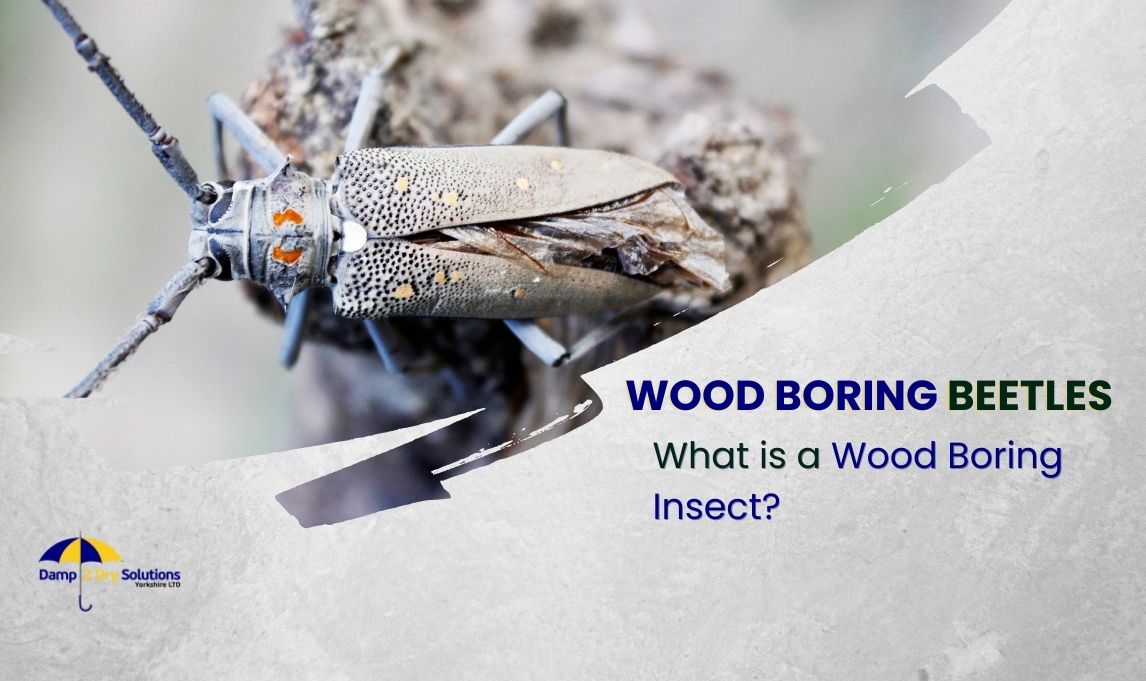Most of us have encountered wood that is riddled with tiny holes. Many people are unaware that this is the result of a woodworm’s efforts. The wood is unsightly and may also be structurally compromised in many circumstances. That’s because Woodworm prefers untreated wood, which includes ceiling joists, struts and beams, flooring, skirting boards, and other structural and safety-related wood.
Read on to learn more about what woodworm insects look like and how to recognize the indications of an outbreak.
What does a woodworm look like?
Woodworms are wood-boring beetle larvae, not worms. The adult beetle lays their eggs between the gaps in the wood, where they will later develop into larvae or grubs. The grubs require food, and the wood will be their only source of nutrition for the next few years.
These worm like larvae dig into the wood and produce tunnels, reducing the density and strength of the wood. The grubs munch their way to the top of the food chain as they mature and expand in size, where they pupate and leave the wood as beetles, and the cycle repeats.
Types of Woodworm Beetles
Here is a detailed list of common woodworm, beetles and larvae found in the UK.
- Anobium Punctatum or Common Furniture Beetle
- Deathwatch Beetle
- Woodboring Weevils
- Powder Post beetle
- European house borer or House Longhorn Beetle
- Fan-Bearing Wood-Borer
- Ambrosia Beetle
Now it’s time to cover your question “What Does a Woodworm Look Like?” and “How to Identify woodworm beetles by their look?”
#1. Anobium Punctatum or Common Furniture Beetle
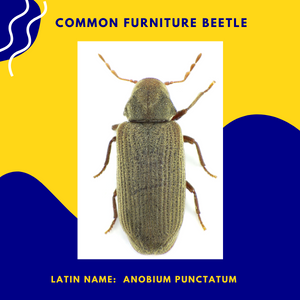
The common furniture beetle, also known as the common house borer (Anobium punctatum), is a woodboring beetle that originated in Europe but is now found worldwide. It bores into the wood during a larval stage and feeds on it. Anobium punctatum adults are long at 2.7–4.5 millimeters (0.11–0.18 in). They have brown ellipsoidal bodies with a monk’s cowl-like prothorax.
Habitat of Anobium Punctatum
House borer thrives on damp basements, furniture, and other woodwork in ancient buildings and decaying wood and trees in wet or moist forest environments.
Woodworms usually enter a house through dead branches or trees from surrounding parks or forest areas in urban or residential regions.
Infestation Symptoms of Common Furniture Beetle
- Approximately 1.5 2mm diameter round holes
- Frass in little mounds seen in tunnels or on surfaces.
- The texture of frass will be rough.
#2. Deathwatch Beetle
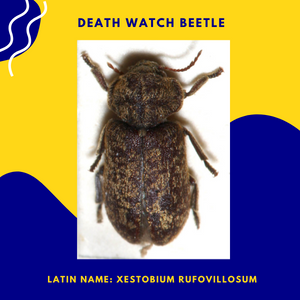
The deathwatch beetle (Xestobium rufovillosum) is a type of woodboring beetle that can infest old buildings’ structural timbers. The mature beetle is brown in colour and measures around 7 mm (0.3 in) in length. Eggs are laid in ancient wood fissures inside structures, trees, and tunnels left behind by previous larvae.
Habitat of Deathwatch Beetle
This beetle can be found in both Europe and North America, including the United Kingdom. It prefers dead or rotting hardwoods and coniferous wood in some situations, especially when a fungal attack has weakened the wood.
Infestation Symptoms of Deathwatch Beetle
- Approximately 3mm diameter round holes
- Tunneling on a large scale.
#3. Woodboring Weevils

The wood-boring weevils are distinguished by their large snout and tiny club-like antennae. Their appearance varies depending on the type of woodboring they do. Adults can be anything from 1 and 40 mm long. They eat rotting wood of any kind.
Habitat of Woodboring Weevils
Adults can live up to 16 months and feed on wood and larvae. Their white eggs are laid on the surface or just below it. The larvae have a curled shape, are white, and bore for 8–9 months along the grain. Pupa grows just beneath the surface.
Infestation Symptoms of Woodboring Weevils
- Tunneling in sapwood usually follows the grain.
- Tunnels are small, with a diameter of about 1mm.
#4. Powder Post beetle
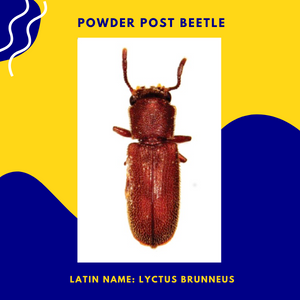
Powderpost beetles are a genus of 70 wood-boring beetles belonging to the Lyctinae family. As a result, they are regarded as infamous pests. Their larvae are C-shaped and white. They are found in mid-reddish-brown colour. They are found in length between 8-9mm.
Habitat of Powder Post beetle
Unlike other beetles, the powder post beetle infests wood before entering your home. It usually enters the wood when it is being stored and cured and then emerges from the finished product. The powder post beetle attacks only the sapwood of wide-ported hardwoods like oak and obeche. The wood must be young, less than 15 years old, and is thus most likely to be found in recently introduced hardwoods like oak flooring or oak kitchen units.
Infestation Symptoms of Powder Post beetle
- 1.5 – 2mm round holes
- Around breakout holes, live insects may be found.
#5. House Longhorn Beetle or European House Borer
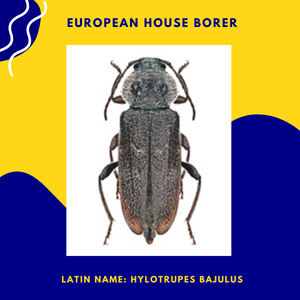
House Longhorn Beetle (Hylotrupes bajulus) or European house borer can grow to be 8–20 mm (0.31–0.79 in) in length, with adult larvae reaching 30 mm (1.2 in). [4] [5] These beetles range in colour from brown to black, with a fine grey furriness on most of the upper surface, giving them a grey appearance.
Habitat of House Longhorn Beetle
This bug is only found in the southeast of England, primarily in the Camberley area. The House Longhorn Beetle feeds on softwood sapwood and can cause severe structural damage to buildings.
Infestation Symptoms of House Longhorn Beetle
- 68mm wide oval emergence holes
- Internal damage that is frequently filled with loose frass.
- When exposed to a severe attack, the surface of wood generally remains thin and fragile.
#6. Fan-Bearing Wood-Borer
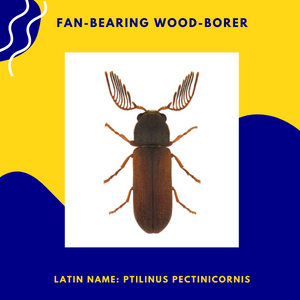
The head fan antennae of this little blackish-brown beetle are remarkable. It prefers to hang out in lumber yards and wooded areas, where it may do a lot of damage to trees.
Habitat of Fan-Bearing Wood-Borer
These beetles are commonly observed on the surface of hardwoods in tunnels, primarily focusing attention along the wood grain. It searches for wood sources in its immediate surroundings.
Infestation Symptoms of Fan-Bearing Wood-Borer
- It exits through 2 mm diameter holes and remains close to the timber’s surface.
- Creates circular tunnels filled with frass that resembles flour.
#7. Ambrosia Beetle

Ambrosia Beetle is narrow with a lustrous dark-brown coloration and tucked-back wings. Usually found in the woods, but can be brought into the house under the right circumstances.
Habitat of Ambrosia Beetle
Ambrosia Beetle prefers all sorts of hardwoods and softwoods and can commonly be found in newly fallen trees or fresh logs.
Infestation Symptoms of Ambrosia Beetle
- Compared to other varieties of beetles, it exits wood through holes that vary in size but are frequently rather huge.
- It makes blue-lined tunnels with rounded edges that run against the grain.
Common Woodworm Identification
Look for the most common indicators of Woodworm listed below to learn how to detect if you have it. When you’ve gathered all of the evidence and suspect an infestation, contact Woodworm control specialists to take care of it for you.
1. Holes Made by Woodworms

The most prevalent and well known indicator of a woodworm infestation is round or oval holes in the wood. They range in size from 1 to 3mm in diameter and have sharp edges, depending on the species that has taken up residence inside your wooden buildings. When an adult beetle departs the wood to locate a mate, these exit holes are known as flight holes.
They aren’t usually indicative of a current infestation, thankfully. If you’ve had Woodworm before, the holes will still be visible, but they won’t be as fresh or have as much frass around them.
2. Frass from woodworms

Frass, also known as bore dust, is a fine powder that is frequently found surrounding or below woodworm holes. When it comes to wood boring weevils, the frass might be a touch sticky at times.
While it’s tempting to imagine these are microscopic wood shavings, this is incorrect; the bore dust is really woodworm waste produced by the larvae while digging. The most straightforward and most obvious approach to tell if you have an active woodworm problem is to check for frass around the holes on a regular basis.
3. Wooden Tunnels
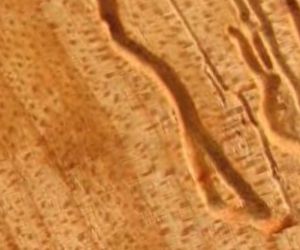
If you can cut a piece of wood, you’ll be able to see the tunnels that have been bored through the wood on closer inspection. This indicator is difficult to identify since it is not always feasible to see beneath the surface of the wood. When the wood splits, you’ll be able to observe these galleries, as they’re also known.
4. Crumbling Wood
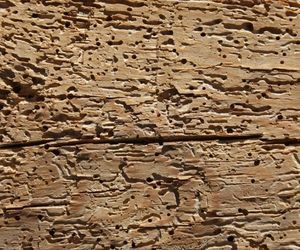
Crumbling wood is commonly encountered around the corners and edges of boards and floorboards as a result of excessive tunneling and flight holes around the margins of the wood. There is just not enough wood to keep the board or frame in form.
This is frequently mixed with timber that is weak or damaged. It’s worth researching the situation yourself or contacting a professional to do it for you if your foot suddenly goes through the floorboard.
5. Adult Beetles Spotted

Whether dead or alive, adult beetles are an unmistakable indicator of an infection. Between March and October, you might notice them exiting the wood, laying around the infested wood, or along with the window sills. If you find dead beetles in an area you don’t regularly visit, such as a basement or a loft, they aren’t necessarily a sign of a current infection.
Conclusion
Woodworm is a significant and hazardous problem in your home. It can not only damage thousands of pounds in structural damage, but it can also endanger your and your family’s health and safety. Follow the steps above to verify that your house’s floorboards, ceiling beams, and columns are woodworm free, whether you suspect you have woodworms or are confident you don’t. If you need answers then you can read the woodworm control answers guide.
To properly analyze your property, look for small exit holes, fine bore dust, tunnels in the wood, crumbling wood, or live or dead insects. The best thing you can do to save your furniture is to contact a professional woodworm exterminator who will treat the contaminated areas with the appropriate tools and in a timely manner.


